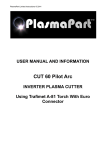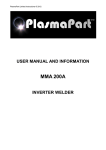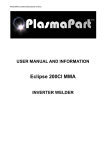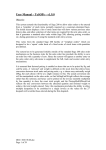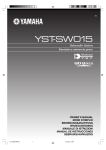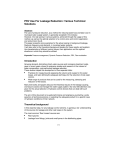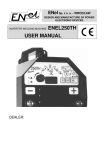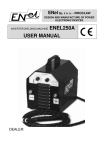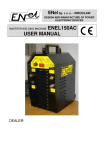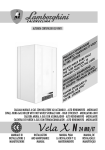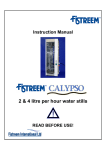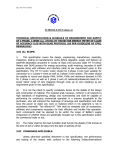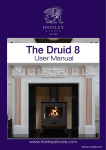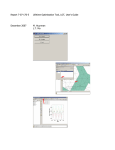Download CUT 50 PILOT PRO
Transcript
PlasmaPart Limited Instructions © 2014 USER MANUAL AND INFORMATION CUT 50 PILOT PRO INVERTER PLASMA CUTTER Using Trafimet S-45 Euro Connector Torch PlasmaPart Limited Instructions © 2014 Thank you for purchasing the PlasmaPart CUT 50 PILOT PRO Plasma Cutter. We have included this information pack as a reference document for all users; it is intended to provide information relating to all areas of plasma cutting from health and safety to operational tips. We strongly advise you to keep this document with the machine. It is important you familiarise yourself with the information within this guide, both for your safety and ease of operation of the unit. Important Health and Safety Information This unit in common with all plasma cutters uses a combination of very high voltage, current and power to generate the high temperatures required to cut metals. A plasma cutter can cause injury or death if used incorrectly. There are several hazards associated with plasma cutting: Heat The plasma beam created at the torch tip exits around 25,000 ˚C this presents a serious hazard if the plasma beam were to come in contact with you, as well as this the molten metal produced in the process can also cause damage or injury to you if your feet or other parts of your body are not adequately protected. Note: This is a Pilot Arc Machine and the Torch will light as soon as the trigger is pressed irrespective of material contact. Plasma cutting should not be carried out within close proximity to any flammable substances or materials. Electricity Unlike conventional welding equipment the voltage present at the torch tip when energised is very high presenting a risk of electrical shock or electrocution if care is not taken in use. The torch tip and hose connection of the machine carry 200V DC. Unlike normal mains electricity a.c. supplies this d.c. supply will cause muscle contraction rather than spasm and may cause the hand to lock onto the supply rather than being thrown off - if you come in contact with it. Great care must be taken to ensure you do not come in contact with the tip, or any contacts on the machine whilst it is on. This machine must be earthed. The high power requirements of this machine are common with all plasma cutters. When set to 28A cutting current or below the machine can be used safely from a standard 13A supply with an appropriate 13 Amp fuse fitted. For cutting requirements above this amperage it is recommended that the machine is connected to a 30 Amp supply. © PlasmaPart Limited 2014 no part of these instructions may be reproduced without prior written consent from PlasmaPart Limited 1 PlasmaPart Limited Instructions © 2014 The machine is fitted with a 32A single phase plug. If in doubt please contact a qualified electrician for advice. Please note that if the nozzle is bought out of contact with the work-piece whilst cutting is being carried out the unit can draw 22A from the mains supply with 40A set current. The nozzle should always be in contact with the work-piece before cutting is started and whilst cutting is carried out - this ensures the cleanest cut, minimises the risk of molten metal being thrown toward the operator and minimises power usage of the machine. Compressed air The unit requires a compressed air supply to operate. All pipe work should be kept in good condition and checked regularly for damage. Air at high pressure can penetrate the skin if directed onto it at close range - this can cause blood clotting and even death. Even at a low pressures compressed air can be dangerous (even fatal) if it is introduced into any orifices of the body. Visible and Ultra Violet Light The visible light generated by the arc process is not as intense as some welding operations but can cause serious eye damage if the eyes are not protected during the cutting operation. SHADE 5 goggles are considered adequate for most purposes and are supplied with the unit. If the eyes become sore or irritated it would be advisable to seek professional help and increase the shading level. The safety glasses provided are also recommended to help protect eyes from flying debris. As with most arc welding processes skin should be protected from exposure to the ultra violet light emitted during the cutting process. Airborne Debris Due to the way a plasma cutter operates airborne debris is generated and blown into the air by the compressed air, it is strongly advised that the unit is operated in a well-ventilated environment. It is also recommended that a mask of appropriate grade is worn to prevent ingress of fine debris into the lungs. Electromagnetic Radiation and Strong Magnetic Fields In common with all welding and cutting machines the CUT 50 emits strong magnetic and electromagnetic fields when in close proximity to the machine. Persons with pacemakers or other artificial life support systems should remain at least 2 metres away from working machines without the advice from a doctor of their system manufacturer’s recommendation © PlasmaPart Limited 2014 no part of these instructions may be reproduced without prior written consent from PlasmaPart Limited 2 PlasmaPart Limited Instructions © 2014 Specification Supply Voltage 1-ph AC 220±15% V Supply Frequency 50~60 Hz Power requirement (at 50A) 6 KVA (Max) Rated input current (at 50A) 30 A (Max) No-load voltage 230 V Output current range 20-50 A Output voltage range 88- V Duty cycle @ 50 Amps Output 60% Efficiency 85% Cut Width 1.0 mm Arc striking model Air Start Pilot Arc Cos φ (η) 0.93 Air pressure 60 psi Instruction Notes 1. Operating environment 1.1 The CUT50 Pilot Pro can be operated in harsh weather conditions at temperatures of between -10 and +40 Degrees Centigrade and a Relative Humidity of 80%. 1.2 Do not place the machine in direct sunlight or operate it in the rain. 1.3 Keep the machine dry and avoid any contact with water. 1.4 Do not use the CUT50 Pilot Pro in a dusty atmosphere or one containing a corrosive or explosive gas. 1.5 If the machine will not be used for a long period of time it should be returned to its original packing box and stored in a dry environment. 1.6 The CUT50 Pilot Pro has an internal fan to cool the high power electronics and the entry and exit ventilators must not be obstructed. Ensure there is sufficient space in front and behind the machine for the forced air to circulate. 1.7 Ensure the power cable is connected to a supply which has the correct voltage and current rating. The CUT50 Pilot Pro has a built in electronic control to adjust for different mains voltage over a limited range. There is a label on the back of the machine indicating the machine setting. Units supplied to the UK will be set for 220Vac (190-255Vac) which is suitable for single phase supplies. The CUT50 Pilot Pro will be seriously damaged if it is connected to a 415V Three Phase supply. 1.8 Always stand the machine on a level surface to prevent the unit overturning. © PlasmaPart Limited 2014 no part of these instructions may be reproduced without prior written consent from PlasmaPart Limited 3 PlasmaPart Limited Instructions © 2014 2. OPERATING SAFETY 2.1 Ensure the working area is adequately ventilated and clear of all flammable materials. 2.2 Avoid physical contact with the cutting tip when the power is on. The tip will be at a potential of 240Vdc when the torch switch is activated, this reduces to approximately 120Vdc during the cutting process. Both voltages can cause serious electric shock. The brass gas connection on the front of the unit is also at these potentials when the torch switch is activated and the mains supply is switched on. 2.3 Always turn the machine power off and remove the plug before servicing or changing the cutting head components. 2.4 When using the machine on site or outside ensure the grounding terminal on the back of the machine is connected to a safety earth. This will prevent any leakage current from the cutting circuit causing an electric shock to the operator. A cable with a cross sectional area of 6mm2 is suitable for this purpose. Neither the torch lead or earth clamp are directly connected to the mains earth inside the unit although the unit case is itself earthed to the mains cable earth wire. 2.5 Do not cut containers or pipes which have held or contain gaseous or liquid fuels or combustible substances. 2.6 Do not cut any containers or pipes which may be under pressure. 2.7 Always wear eye protection. This is to protect your eyes from both the arc and also sparks which are produced during the cutting operation. 3. Setting up the machine 3.1 Check the cutting torch head is assembled correctly. An assembly diagram is shown in Appendix 4. 3.2 There are two types of cutting components included with the equipment. Both versions are suitable for cutting currents up to 50A, one for cutting and one type for gouging. The correct length electrode must be fitted to match the tip length being used. The swirl ring is the same component for all assemblies. The connector with a ¼ BSP (brass) connection provides both the compressed air and cutting current to the torch. There is an electrical connection included inside the air pipe. Ensure this fitting is tightly connected to the left hand air connection at the bottom (front left) of the unit. The second 2 pole (silver) connector from the torch is the switch contacts which activates the unit to cut. This is connected to the central socket at the bottom (front) of the CUT50 Pilot Pro The red ‘flying lead’ from the torch connects to the red terminal on the front panel. The fourth connector connects the return current to the material being cut. A lead with a large crocodile clip is provided in the box. 3.3 Connect the mains cable to a suitable high current supply. The OC light will come on and the unit will ‘lock out’ if the mains supply at the unit drops below the lower 15% voltage limit when the ‘cut switch’ is operated. There is an internal monitoring function inside the unit to prevent damage to the electronic circuits. The current taken from the mains supply is just over half the value set on the front panel current control. I.e. if the current control is set to 40A the unit will take 22A from the mains supply. See the fault finding guide for further information. © PlasmaPart Limited 2014 no part of these instructions may be reproduced without prior written consent from PlasmaPart Limited 4 PlasmaPart Limited Instructions © 2014 3.4 Connect the air regulator to the compressor with the compressor set to its maximum pressure output. The CUT 50 PILOT PRO consumes approximately 100 litres (3.5 cu ft.) of air per minute at 60 PSI (4 bar, 0.4 MPa). For a general air pressure setting: Set the current control to 20A and turn the mains power switch on. Point the torch Nozzle away from you and press the trigger. Do not touch the cutting tip during this operation as it will be at a high voltage. Adjust the pressure regulator to set 60 psi on the gauge. The regulator is adjusted by pulling up the central knob and turning clockwise to increase the pressure. Switch the machine power off. Do not keep the torch switch depressed for long periods without contacting the metal. Connect the earth electrode to the material being cut. It may be necessary to remove a small part of the surface corrosion if black steel or rusty Iron is to be cut. This will ensure the earth electrode is making good contact with the base metal. The torch will cut without this connection but the cut depth will be compromised. 3.5 Observe the CUT50 Pilot Duty Cycle, which is 60% at full output. If a long thick cut has been made for say 6 minutes, allow the machine to rest for 4 minutes before making a further cut. This will give the electronics time to cool. If machine gets too hot a monitoring circuit will automatically stop the machine working until the unit has reached a safe level to continue. This is indicated by the OC light illuminating on the front panel and the arc will not strike. Leave the machine power on to allow the fan to cool the machine. It is necessary to turn the machine power switch off and on again to reset the monitoring circuit. 3.6 The cutting current is maintained at the value set by the control on the front panel. The CUT 50 Pilot cannot be overloaded; the machine has a built in electronic control circuit which ensures the current flowing remains at the value set by the control knob. 3.7 If fitted set the after cut air flow switch on the front of the machine to 2.5 or 5 seconds. This keeps the air flowing for a pre-set time to cool and clear debris from the cutting tip. As a guide, set the switch for 2.5 seconds for currents up to 25A and 5 seconds for currents above 25A. 3.8 The CUT 50 PILOT PRO is now ready to cut. 3.9 4. Cutting Operation To begin the cut place the nozzle in direct contact with the material and pull the trigger, the plasma will start and cutting can commence. Note: The material can be rusty, painted or badly corroded, there is no need for a clean surface as the pilot arc will burn through to the base material. Keep the nozzle in contact with the material during the cutting operation. Wait for air flow to stop before trying to start a cut. The torch will not light if air is flowing from the nozzle when the cut switch is pressed. © PlasmaPart Limited 2014 no part of these instructions may be reproduced without prior written consent from PlasmaPart Limited 5 PlasmaPart Limited Instructions © 2014 4.1 The cutting current is dependent on three parameters; material thickness, speed of cutting. (Travel speed of the torch) and standoff (distance between the cutting tip and parent material being cut) in practice it has been found that it is easier to set a current appropriate to the material thickness then adjust the speed of cutting to achieve the desired result if the tip standoff is kept constant. When the correct combination is achieved the sparks from below the material being cut will lag slightly behind the cutting tip. Move too quickly and the sparks tend to come from above the cut and the plasma will not penetrate all the way through the material. Moving too slowly will result in a wider cut, heat distortion and a build-up of dross (slag) on the underside of the material. Eventually the arc will be lost. It is good practice to try a few cuts on scrap material where you can establish a speed of cutting that is comfortable to achieve. The interdependence of the three parameters is explained in more detail below. 4.2 The two terms that are commonly used to describe the quality of the cut in Plasma cutting are Kerf (cut width) and Dross (slag). 4.3 Kerf is the width of material (perpendicular to the torch and cut axis) removed during the plasma cutting process. Kerf is affected by two variables. Cutting Speed The faster travel speeds will result in a narrower kerf. The kerf will continue to narrow until loss of penetration occurs. Slower travel speeds will result in a wider kerf until loss of arc occurs. Cutting Amperage Increasing cutting amperage will result in a wider kerf. Continuing to increase current will widen kerf until the nozzle is destroyed. Lowering amperage will result in a narrower kerf and a more positive cut angle until penetration is lost. Standoff is the distance maintained between the torch plasma exit hole and work-piece. The tips supplied with your S-45 torch have a built in standoff between the plasma exit and work piece and have been designed to remain in contact with the material being cut. If the standoff is increased during cutting the CUT 50 PILOT PRO has an arc voltage feedback system which will increase the arc voltage as the standoff distance increases and widen the kerf. Continuing to increase standoff will eventually lead to loss of cut. The unit will electronically maintain the constant set current if the standoff distance is changed. 4.4 Dross (slag) is the excess material that spatters and builds up on the underside of the material as you cut. Dross occurs when the operating procedure and technique is less than optimal. It will require practice and experience to obtain cuts without dross. Although less than optimal cuts will contain dross, it is relatively easy to remove by breaking it off using pliers or chipping off with a chisel. A combination of factors contributes to the build-up of dross. These include material type, material thickness, amperage used for the cut, speed of the torch across the work-piece, condition of the torch tip, air pressure, etc. Do not use more output current than is necessary and adjust speed of cut to minimise dross build-up on underside of cut. Try carrying out further experiments adjusting current and speed to minimize dross and obtain a satisfactory result. © PlasmaPart Limited 2014 no part of these instructions may be reproduced without prior written consent from PlasmaPart Limited 6 PlasmaPart Limited Instructions © 2014 4.5 Cutting tip angle. It is important to keep the cutting tip near to vertical in the direction of travel and also at right angles to the direction of the cut. Basically the plasma will cut in the direction the tip is pointed. This can be used to advantage if a weld preparation is needed on the material being cut. When reaching the end of the cut ‘tip’ the torch slightly away from the end of the material to sever the final bridge. The same technique in the opposite direction can also be useful when starting the cut. Please note that not all S-45 torches and consumables available are of the same design and dimensions. The torch, torch cable and spares provided with this unit and available from us have all been selected and inspected to ensure they meet our required specification. Some cutting tips available from other suppliers will require a standoff to be maintained in use and other consumable components may require a higher air pressure to function correctly; some parts available will not function properly at all 5. Maintenance 5.1 Before use ∙ Check the power connection and air supply hose for damage. Repair or replace any damaged items before use. ∙ Check the condition of the black shroud, cutting tip, electrode and swirl ring. Replace as necessary. ∙ Check the torch is assembled correctly for the cutting current to be used. ∙ Check the earth connection and cutting torch cables for damage. Repair or replace as necessary. Ensure these are tight to their respective connections on the unit. 5.2 During use ∙ Regularly check the cutting tip and shroud for a build-up of dross (slag) from the cutting process. ∙ Brush off any build up with the wire brush provided. Avoid enlarging the hole in the tip through which the Plasma exits. ∙ Always switch off the machine before touching the cutting tip or dismantling the torch. 5.3 After use ∙ Disconnect earth lead and torch from the unit ∙ Dismantle the torch and clean the shroud, electrode, swirl ring and cutting tip. The electrode and cutting tip can also be cleaned with 120 grit wet and dry paper. ∙ Re-assemble the torch and store items in a safe place. The shroud is easily damaged, if it comes into sharp contact with a hard surface. This information should be considered important and you must understand it before using the CUT 50 PILOT PRO plasma cutter for your own and others safety. If there is something you don’t understand please contact PlasmaPart Ltd. for clarification. We are here to help! © PlasmaPart Limited 2014 no part of these instructions may be reproduced without prior written consent from PlasmaPart Limited 7 PlasmaPart Limited Instructions © 2014 Declaration of Conformity The undersigned company - PlasmaPart Ltd. Unit 7, Waldron Court, Prince William Road, Loughborough, Leicestershire. LE11 5GD declares that the product identified and described on this page has been tested by their supplier and complies with standard EN 60974-7 in accordance with the requirements of directive EEC 73/23 Low Voltage Directive Certificate valid until 20.11.14 Portable Appliance Testing This equipment is tested in accordance with the IEE Code of Practice - 3rd Edition Inspection and Testing of Electrical Equipment - by a person holding recoginised qualifications using calibrated test equipment as part of PlasmaPart Ltd. PreDespatch QA procedures. © PlasmaPart Limited 2014 no part of these instructions may be reproduced without prior written consent from PlasmaPart Limited 8 PlasmaPart Limited Instructions © 2014 Troubleshooting – Appendix 1 PROBLEM Plasma arc will not start POSSIBLE CAUSE SOLUTION Unit not powered up Check mains supply, on/off switch is on Work clamp connection Check ground clamp has a good connection to the material being cut, clean surface of material if it is dirty or corroded Air supply is low pressure Check air is flowing from the torch tip with cut switch pressed. Check the compressor is maintaining 60psi at the gauge while cutting is in progress. Check the regulator fittings have been assembled properly using PTFE tape. Check the cutting tip is not blocked by dross OC Light on front panel of unit comes on Switch machine off and wait about 2-3 minutes, Switch machine back on. This can occur if the unit duty cycle is exceeded (overheating) Use 32A cable for power lead extensions, a standard 13A type is unsuitable. If the voltage at the unit 'dips' below the minimum value as the arc strikes the unit will turn off and the OC light will come on. Try operating the cutter at 20A set current, if this is OK then there is a problem with the stability of the mains supply to the unit. Use a different power source or thicker mains cable to connect to the unit mains lead. The unit will draw 28A from the mains supply when cutting at 50A. Torch assembly / air flow Check the torch has been assembled correctly.. Note the presence and position of the swirl ring. See Appendix 4 for further information. Wait for air flow to stop before trying to start a cut. The torch will not light if air is flowing from the nozzle when the cut switch is pressed. Technical problem with the unit [email protected] PlasmaPart Limited Instructions © 2014 Troubleshooting - Appendix 2 PROBLEM Plasma arc stops while cutting POSSIBLE CAUSE Hand too tense, inadvertently releasing the cut switch SOLUTION Hold the torch lightly against the material being cut, don't push down. Try and relax the hand. Cutting speed too slow Torch moved too far away from material Compressor unable to keep up with air demand Check air pressure gauge reading when cut stops. Check air pressure is 60psi with cut switch pressed. Check torch lead connections at unit and torch are tight. Check torch hose is undamaged. Check compressor, give the compressor time to recover if making long cuts when using a smaller compressor. Check the regulator fittings have been assembled properly using PTFE tape. Sparks are shooting upward not downward through the material Technical problem with the unit [email protected] Plasma arc not piercing material Torch travel speed too fast Check grounding clamp is making a good connection to the material being cut and is tightly connected at the unit. Clean a patch of material for clamp if rusty Increase current PlasmaPart Limited Instructions © 2014 Troubleshooting – Appendix 3 PROBLEM Insufficient cut penetration POSSIBLE CAUSE SOLUTION Cutting speed too fast Insufficient current Worn or damaged torch electrodes Beginning and end of cut not severed Torch positioning Tilt the top of the torch towards the direction of travel as you start the cut. Tilt it away from the direction of travel when you are finishing the cut. Dross build up on parts of the cut Cutting speed too slow or not consistent Try keeping a constant and steady cut speed for a set current Material getting too hot Allow material to cool before continuing the cut Current too high Consumables wear quickly Air pressure too low Re-check gauge pressure remains at 60psi when the cut switch is actuated and remains at 60psi for the duration of the cut. Torch position Tilt the top of the torch toward the direction of travel when cutting the thickest material. This will reduce the blow back into the torch tip. Poor maintenance Frequently clean the dross off the cutting tip using the wire brush provided. Cut is not vertical Torch position The torch cuts in the direction that the plasma arc is pointed. Keep the torch vertical for a vertical cut. The tip can be angled to produce a weld prep if this is required on the material being cut. Torch will not switch off when cut switch released Cut switch problem Check the cut switch contacts at the machine end of cable for correct on/off circuit Electronic Fault in unit [email protected] PlasmaPart Limited Instructions © 2014 Appendix 4 S-45 Torch Assembly Instructions Note: The Swirl Ring fits tightly to the Nozzle and can remain attached and easily lost when the torch is disassembled. Ensure this is re-fitted in the correct place when the torch is re-assembled. © PlasmaPart Limited 2014 no part of these instructions may be reproduced without prior written consent from PlasmaPart Limited 12 PlasmaPart Limited Instructions © 2014 SAFE SYSTEM OF WORK – PLASMA CUTTING (Please note: This is a generalised SSW and it should adapted to suit your own operations and systems) RISKS There are significant Health and Safety risks that can occur from plasma cutting processes, these are detailed if the Risk Assessment and comprise the following: Intense ultra violet and infrared radiation Fumes from the cutting process Heat Electric shock Electromagnetic Radiation Ignition of combustible material Unauthorised use Danger from pipes, vessels and cables SAFE SYSTEM OF WORK INTENSE ULTRA VIOLET AND INFRA RED RAYS The operator should always wear suitable eye protection and ensure other observers’ eyes are also protected. Post signs to warn other people of the visual danger from the operation or work in a restricted area. FUMES Only use the equipment in a well-ventilated area. HEAT Use appropriate gloves, clothing and footwear during all cutting processes. Point the torch into a safe area before pulling the trigger. The Pilot Arc will start instantaneously and cause severe burns if it made contact with exposed or covered skin. ELECTRIC SHOCK Always turn the machine power off before servicing the cutting torch. Check the mains plug and cable for cuts or burns before the power is turned on. Report any defects before using the machine © PlasmaPart Limited 2014 no part of these instructions may be reproduced without prior written consent from PlasmaPart Limited 13 PlasmaPart Limited Instructions © 2014 Ensure colleagues are aware of how to deal with a person suffering from electric shock. ELECTROMAGNETIC RADIATION Any person fitted with a heart pacemaker or other artificial electronic life support system must not be permitted to be closer than 2m of any operational electrical cutting equipment. IGNITION OF COMBUSTIBLE MATERIAL Combustible materials are not to be used, stored or allowed to accumulate in the welding/cutting area. Sparks and molten metal from the cutting process can travel a long way. UNAUTHORISED USE (CUT 80/100/120 only) Always switch the machine OFF and turn off and remove the safety lock key before leaving the machine unattended. The torch will not light with the key switch set off. DANGER FROM PIPES, VESSELS AND CABLES Ensure any pipework to be cut is free from chemical contamination. Some chemical elements could explode or create noxious fumes when heated to plasma cutting temperatures. Ensure any vessel or cylinder to be cut does not contain any flammable gas, fuel or pressure before cutting. Avoid working near to cables which may be live. Do not cut cable which has insulation, burning insulation could create noxious fumes. Keep the machine power cables and torch power connection away from the cutting area. © PlasmaPart Limited 2014 no part of these instructions may be reproduced without prior written consent from PlasmaPart Limited 14 PlasmaPart Limited Instructions © 2014 RISK EVALUATION AND PRECAUTIONS FOR WELDING AND CUTTING OPERATIONS (Please note: This is a generalised Risk Assessment and it should adapted to suit your own operations and systems) The potential risks from welding or cutting operations are identified as follows: 1. 2. 3. 4. 5. 6. 7. Intense ultra violet radiation and Infrared rays Fumes Heat Electric Shock Electromagnetic radiation / Strong magnetic fields Ignition of combustible material Compressed Air The following safety precautions have been taken by the Company to overcome or mitigate the risks involved with electrical welding or cutting operations: INTENSE ULTRA VIOLET RADIATION AND INFRA RED RAYS To protect from intense visible and ultraviolet light safety glasses or a helmet will be provided with an appropriate filter lens to reduce the light intensity and protect the face and eyes from the heat generated in the processes. FUMES A downdraught ventilation and filtration cabinet has been installed to remove sparks and welding fumes and gasses from the immediate vicinity of the operator. Following primary filtering the contaminated air is circulated outside the building. HEAT Appropriate clothing and gloves are provided and will be worn during all welding and cutting processes. ELECTRIC SHOCK Whilst the effect of a shock from the high voltage is unpleasant it is unlikely to be fatal. The power supply to the machine should be switched off before adjustment or servicing is carried out on the torch to prevent accidental contact with the spark or cutting power source. Most welding plant is classified as Class 1 Moveable Equipment and in an industrial environment there is a legal requirement that user checks are made each time before the equipment is used. ELECTROMAGNETIC RADIATION Regulations state that any person fitted with a heart pacemaker or other life support device will not permitted to be closer than 2 metres of any operational welding or cutting equipment. A warning sign to this effect is included on entry doors to the welding/cutting area. © PlasmaPart Limited 2014 no part of these instructions may be reproduced without prior written consent from PlasmaPart Limited 15 PlasmaPart Limited Instructions © 2014 IGNITION OF COMBUSTIBLE MATERIAL Combustible materials are not to be used, stored or allowed to accumulate in the welding/cutting area. USE OF COMPRESSED AIR The unit requires a compressed air supply to operate. All pipe work should be kept in good condition and checked regularly for damage. Air at high pressure can penetrate the skin if directed onto it at close range - this can cause blood clotting and even death. Even at a low pressures compressed air can be dangerous (even fatal) if it is introduced into any orifices of the body. © PlasmaPart Limited 2014 no part of these instructions may be reproduced without prior written consent from PlasmaPart Limited 16

















